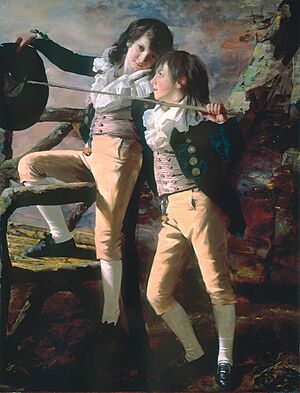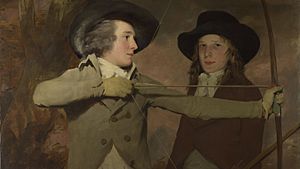Henry Raeburn facts for kids
Quick facts for kids
Henry Raeburn
|
|
|---|---|
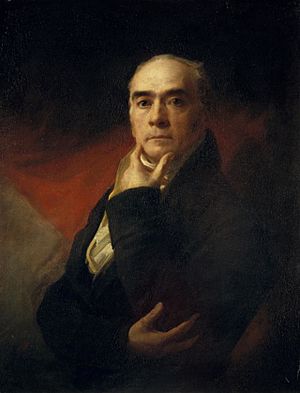
Raeburn in a self-portrait, c. 1820
|
|
| Born |
Henry
4 March 1756 Stockbridge, Edinburgh, Scotland
|
| Died | 8 July 1823 (aged 67) Edinburgh, Scotland
|
| Known for | Portrait painting |
| Spouse(s) | Ann Edgar |
| Elected | FRSE, RSA, RA |
| Patron(s) | King George IV |
Sir Henry Raeburn (born March 4, 1756 – died July 8, 1823) was a famous Scottish artist. He was known for painting portraits of people. He even became the official Portrait Painter for King George IV in Scotland.
Contents
The Life of Henry Raeburn
Henry Raeburn was born in a village called Stockbridge. This village is now part of the city of Edinburgh, Scotland. His father was a manufacturer. Henry had an older brother named William.
Sadly, Henry became an orphan. His older brother William helped him. Henry went to Heriot's Hospital for his education. When he was 15, he started learning to be a goldsmith in Edinburgh. He made small drawings on ivory for jewelry.
From Goldsmith to Painter
Henry soon started painting tiny portraits. These were called portrait miniatures. He became good at them and found people who wanted to buy his art. Then, he started painting with oil paints. He taught himself how to do this.
His goldsmith boss, James Gilliland, saw Henry's talent. He introduced Henry to David Martin. Martin was a leading portrait painter in Edinburgh. Henry learned a lot by copying other portraits. Soon, he decided to become a full-time painter. His first known portrait is of George Chalmers, painted in 1776.
Travels and Marriage
When Henry was in his early twenties, he met Ann Edgar. She was a young lady he saw while sketching outdoors. Ann was a widow and had a lot of money. She was fascinated by Henry, and they got married within a month.
Having money helped Henry focus on his art. He decided to travel to Italy, which was common for artists. In London, he met Sir Joshua Reynolds, a very important artist. Reynolds gave him advice on what to study in Rome. He told Henry to look at the works of Michelangelo.
In Rome, Henry met other artists and an antique dealer. The dealer gave him great advice: "never copy an object from memory." This meant Henry should always have his subject right in front of him. After two years of studying in Italy, Henry returned to Edinburgh in 1787. He began a very successful career as a portrait painter.
Famous Subjects and Style
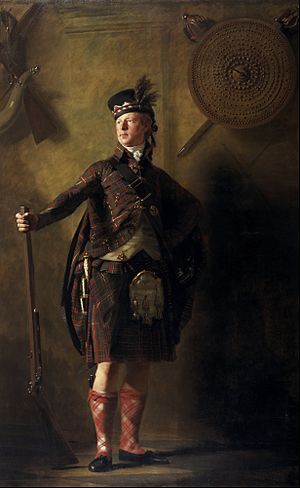
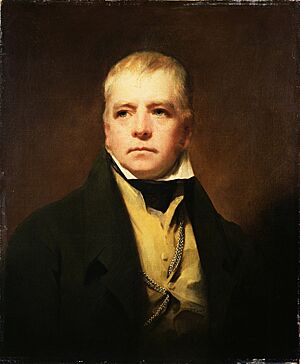
Raeburn painted many important people in Edinburgh. These included famous writers like Sir Walter Scott and Henry Mackenzie. He also painted thinkers like Dugald Stewart. His later works showed strong characters and unique lighting.
Some people thought he was not as good at painting women. But his portraits of his wife and Mrs. R. Scott Moncrieff show how skilled he was. Henry Raeburn spent most of his life in Edinburgh. He rarely visited London. This helped him keep his own unique style. He became a very important artist in Scotland during the early 1800s.
People who sat for him often said, "You would never take him for a painter." This was because he had so many other interests. But as soon as he picked up his brush, he was all artist.
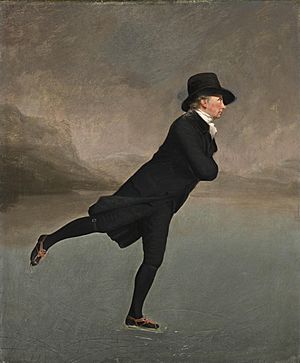
Later Life and Legacy
In 1812, Henry Raeburn became president of the Society of Artists in Edinburgh. He also joined the Royal Scottish Academy. In 1822, King George IV visited Scotland. The King made Henry a knight. This meant he was now "Sir Henry Raeburn." He also became the King's official painter for Scotland.
Sir Henry Raeburn died in Edinburgh on July 8, 1823. He is buried in St. Cuthbert's churchyard. His studio was later used by another artist, Colvin Smith.
Raeburn was a very popular and successful portrait painter. He was great at capturing a person's true look. His paintings are known for their strong characters and realistic details. He used dramatic lighting and bold brushstrokes. Another artist, David Wilkie, said Raeburn's brushwork reminded him of the Spanish painter Diego Velázquez.
Raeburn was known for painting directly from life. He did not make many sketches beforehand. This made his paintings feel very fresh and lively. His style was different from other artists of his time. His work even showed hints of future art movements like romanticism and Impressionism.
Notable Works and Subjects
Sir Henry Raeburn painted over a thousand portraits during his 50-year career. Here are some of the people he painted:
- Rev Robert Dickson
- Sir George Abercromby, 4th Baronet
- Countess of Aboyne, (Lady Mary Douglas, daughter of James, fourteenth Earl of Morton)
- Dr Alexander Adam
- Robert Adam
- Mrs Robert Adam
- Archibald Alison
- Alexander Allan
- David Anderson
- Sir David Baird
- Mrs Henry Balfour (Jane Elliot)
- Lady Belhaven
- Mrs George Bell
- Mrs E Bethune
- The Binning children
- Hugh Blair
- Mrs Irvine J Boswell
- Helen Boyle
- Andrew Buchanon
- John Campbell of John Campbell Snr & Co.
- Colonel Alexander Campbell of Possil
- Mrs Alexander Campbell of Possil
- Sir Duncan Campbell, Scots Guards
- Master John Campbell of Saddell
- Rev. Alexander Carlyle
- Alexander Carre of Cavers
- Master Cathcart
- Sir Francis Leggatt Chantrey
- Charles Christie
- Miss Jean Christie
- John Clerk, Lord Eldin
- Mrs Jean Cockburn Ross
- Jacobina Copland
- William Creech
- John Crichton-Stuart, 2nd Marquess of Bute
- James Cruikshank
- Mrs James Cruikshank
- John Cuninghame of Craigends
- Mrs Alexander Dirom, (Anne Fotheringham)
- Lady Harriet Don, with her son
- Lord Douglas (Earl of Home), as a student
- Elizabeth Douglas of Brigton (née Graham)
- Margaret Douglas, of Brigton, afterwards Mrs. Hunter, of Burnside
- Rev. Robert Douglas, D.D., of Galashiels; died 1820
- The Drummond children
- George Duff
- James Duff, 4th Earl Fife
- Norwich Duff
- Henry Dundas, 1st Viscount Melville
- Thomas Elder (Lord Provost of Edinburgh)
- Lady Elibank
- William Fairlie
- Archibald Farquharson of Finzean
- Robert Fergusson and his brother Lieutenant-General Sir Ronald Fergusson, "The Archers" (Royal Company of Archers)
- William Forbes of Callendar (1756–1823), coppersmith and landowner
- Mrs Gevine
- Eleanor Margaret Gibson-Carmichael
- Karl Ludwig Giesecke
- William Glendonwyn
- Mrs Glendowyn and her daughter Mary
- Niel Gow
- John Gray of Carntyne
- Mrs James Gregory (Isabella McLeod)
- Mrs Elizabeth Hamilton (1757–1816), writer and educationalist
- Major James Lee Harvey, Gordon Highlanders
- Thomas Robert Hay, 11th Earl of Kinnoull
- Captain Hay of Spot
- Mrs Andrew Hay (Elizabeth Robinson)
- Mrs Alexander Henderson
- Principal George Hill of St Andrews
- Mrs George Hill
- John Home
- The Rt Hon Charles Hope-Weir
- Hugh Hope
- Thomas Charles Hope, physician and chemist
- Francis Horner, political economist
- Dr James Hutton, geologist
- Captain Charles Inglis, naval officer
- Sir Patrick Inglis, 5th Baronet of Sunnyside
- John Jameson, founder of Jameson Irish whiskey, and his wife Margaret Haig
- Francis Jeffrey, Lord Jeffrey
- John Johnstone, Betty Johnstone and Miss Wedderburn
- Mrs Johnston of Straiton
- Mrs Johnstone of Baldovie
- Dr Colin Lauder (1750–1831), FRCS, & Burgess of Edinburgh
- Zepherina Loughnan, Mrs Henry Veitch of Eliock
- William Macdonald of St Martin's
- Colonel Alexander Ranaldson MacDonell of Glengarry (1771–1828)
- Allan MacDougall WS of Gallanach and Hayfield
- Lt. Gen. General Hay MacDowall
- Mrs George Mackay of Bighouse (Louisa Campbell)
- Henry Mackenzie
- Francis MacNab, The MacNab
- Robert Macqueen, Lord Braxfield (1722–1799), Lord Justice-Clerk 1798
- George Malcolm
- Mrs Malcolm
- Mrs Hugh Smyth Mercer (née Wilson)
- Captain Patrick Miller
- Robert Scott Moncrieff
- Alexander Monro
- Sir James Montgomery, 2nd Baronet of Stanhope
- Thomas Mure of Warriston
- Sir William Nairne, Lord Dunsinane, 5th Baronet of Nairne
- Sir William Napier, Baronet
- Lord Newton
- Rev. Principal Nicoll, D.D.
- Mrs George Paterson of Huntly Castle
- Mrs James Paterson
- The Patterson children
- John Playfair
- Henry Raeburn
- Lady Raeburn
- Miss Davidson Reid
- John Rennie the Elder, engineer
- Professor William Richardson
- William Robertson
- Adam Rolland of Gask
- Daniel Rutherford
- Colonel Francis James Scott
- Sir Walter Scott, 1st Bt
- Alexander Shaw
- Mrs Simpson
- Sir John Sinclair, 1st Baronet
- Andrew Spottiswoode
- Dugald Stewart
- Mrs Anne Stewart
- Lieutenant General William Stuart (1778–1837)
- John Swinton, Lord Swinton
- John Tait and his grandson
- John Tait of Harvieston
- Rev John Thomson (1778–1840) of Duddingston
- Eliza Tod of Drygrange (née Pringle)
- Lady Anne Torphicen
- Captain Willian Tytler
- Miss Eleanor Urquhart
- James Usher of Toftfield
- Rev Robert Walker (1755–1808) Skating on Duddingston Loch
- Dr Wardrop of Torbane Hill
- Rev Sir Henry Moncrieff Wellwood
- Hugh William Williams
- Lord Woodhouselee
- Dr Rev David Johnston (1934 - 1824) Founder of Edinburgh Asylum for the Industrious Blind (now Royal Blind)



